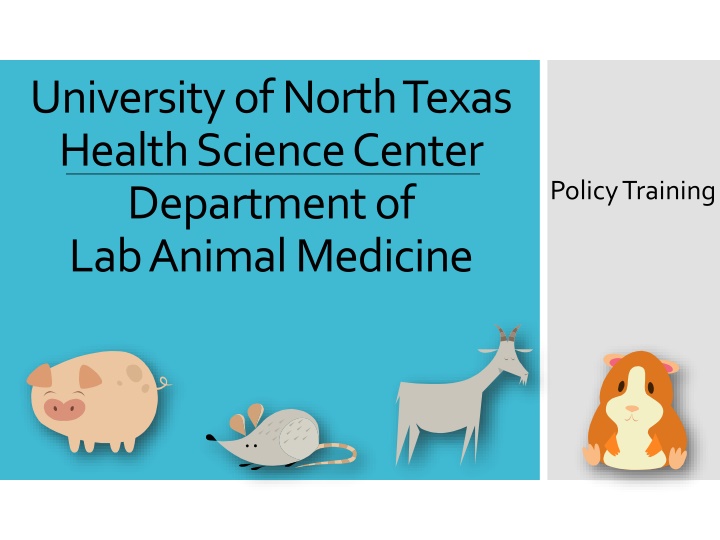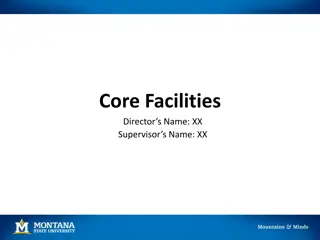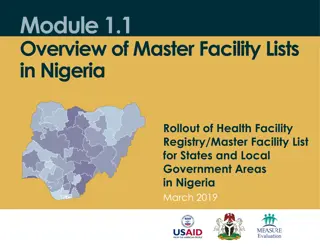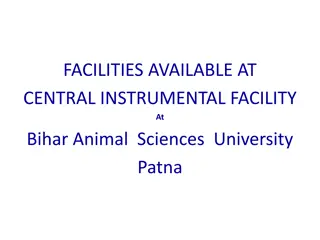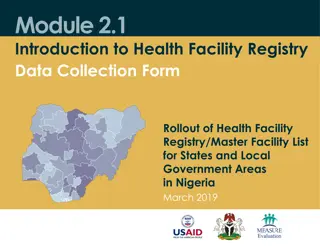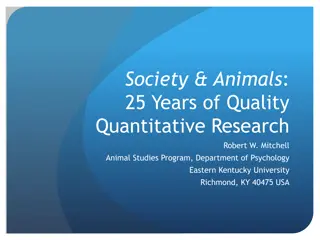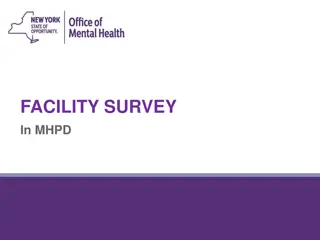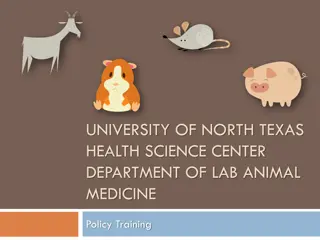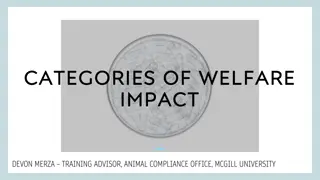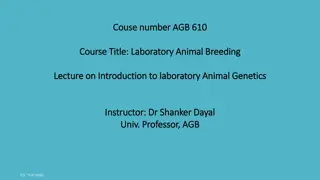Guidelines and Policies for Lab Animal Facility Access and Management
The Department of Lab Animal Medicine at the University of North Texas Health Science Center outlines important policies and procedures for accessing and managing the lab animal facility. From training requirements to access protocols, this comprehensive guide emphasizes safety, security, and compliance with regulations. Key areas covered include authorization processes, visitor guidelines, attire standards, and biosecurity measures to prevent cross-contamination. Adherence to these guidelines ensures a controlled environment for animal research and promotes occupational health and safety practices.
Download Presentation

Please find below an Image/Link to download the presentation.
The content on the website is provided AS IS for your information and personal use only. It may not be sold, licensed, or shared on other websites without obtaining consent from the author.If you encounter any issues during the download, it is possible that the publisher has removed the file from their server.
You are allowed to download the files provided on this website for personal or commercial use, subject to the condition that they are used lawfully. All files are the property of their respective owners.
The content on the website is provided AS IS for your information and personal use only. It may not be sold, licensed, or shared on other websites without obtaining consent from the author.
E N D
Presentation Transcript
University of North Texas Health Science Center Department of Lab Animal Medicine Policy Training
Presentation Overview Tour of vivarium Animal handling
Monday Friday, 7:00 am -5:00 pm Limited staff on weekends -if you need immediate assistance, please call Marcie Dorsett by cell phone DLAM Staff For general questions, contact Administrative Desk at x2017
Director/Veterinarian Dr. Daniels, DVM Facility Manager Marcie Dorsett Operations Analyst Lacy Bowen Animal Health Technician Tito Nelson Lab Animal Attendants Staff who work in your rooms on a daily basis DLAM Staff
Access granted after completion of the following: Online CITI Modules Medical History Questionnaire Added to the protocol via amendment by your PI Attend Policy Training & Hands-on Training Facility Access Key and access card request form signed by your supervisor, and DLAM, then submitted to campus police (this form must be separate from your lab key request) Separate training for access to the ABSL2 suite
No unauthorized visitors are allowed in the vivarium Unless approved by the Director of DLAM or his designee Visitors mustsign in at the DLAM office Facility Security Have your badge visible when inside the vivarium Do not allow another individual to use your badge and/or keys
Wear clean lab coat or clean scrubs Solid shoes (prefer rubber soles) Avoid heavy cologne or perfume Do not smoke in lab coat NO CELL PHONES allowed in the animal facilities! Laboratory Apparel
Do not enter other animal roomsto prevent cross-contamination Wear proper PPE when handling animals Gloves Mask Yellow gown May include shoe covers Occupational Health & Safety Working with potential zoonotic species Do not enter the Clean Room Clean up after yourself Do NOT place cages on the floor
Sharps containers All procedure rooms and labs must have sharps containers Do NOT leave needles in the room For disposal of full Sharps Containers contact x2181 and designated staff will pick them up (IACUC SOP # 017) Occupational Health & Safety Fire alarms Please exit the facility Electronic devices are not permittedin the animal facility
Bites and Scratches Wash the area with soap and water Report the incident to your supervisor (they will decide if it should be reported to the Safety Office) Occupational Health & Safety Allergies Most common health problem Wearing proper PPE can help prevent them If you do develop allergies, let your supervisor know
Animal Health Assessed by DLAM staff in the morning and afternoon Notify DLAM staff immediately, and fill out an orange, Med Case card Animal Health & Husbandry
Common things to look for in rodents: Activity level - lethargic Behavior vocalizing, self-trauma, aggressive Food/Fluid intake decreased feces/urine Eyes red staining Fur unkempt, soiled fur Posture hunched Respiratory open mouth, labored breathing Others seizures, tremors, tumors, infected wounds, paralysis Assessing Animal Health
Dead animals Place the animal in a glove or trash liner, and give it to DLAM staff for proper disposal If DLAM finds a dead animal, a notification will be left on the cage or on the door of the animal room Animal Health & Husbandry Cage changes/Room cleaning schedule The schedule is posted on the room door All caging is changed at least once every two weeks, some require more frequent changes Concerns/questions? Please contact Marcie Feeding DLAM feed ad libitum, a pelleted diet to all rodents unless they are on a restricted diet Concerns/questions? Please contact Marcie
UNT Health Science Center at Fort Worth Department of Lab Animal Medicine PI: DANIELS Dept: DLAM Protocol #:2016-0016 Ext: 2017/2015 P.O. #: 138390 Location: 12B Source: Charles River Species: RAT Strain: SD Sex: Male Weight: 75-100 grams DOB: 07/10/2017 DOA: 08/14/2017 Cage Cards (Provided by DLAM) Please do not deface or remove the cards We provide various pre-printed cards for your use Animal density requirements # of animals per cage is dependant on many factors For specific information regarding housing of the animals on your protocol, please contact Marcie Refer to The Guide for more information Animal Health & Husbandry Dirty or soiled caging Please bring them to the cage wash room If you find a flooded tub, notify DLAM personnel
Sentinel Program These animals are for DLAM use only Animal Health & Husbandry Do not remove or handle these animals They are used for pathogen testing Sentinel animals are housed in each animal room They are indicated by a different colored cage card
Approved vendor only (www.unthsc.edu/research/laboratory-animal-medicine) Contact your depart. Admin. for animal orders Submit Animal Purchase Request to dlam@unthsc.edu Incoming & Exporting Lab Animals Not on the approved list? Must go through Tito (follow the IACUC Quarantine SOP #025, and a UNTHSC Animal Shipping record must be filled out) Exporting animals from UNTHSC to any other facility must also go through Tito; all types of couriers must be approved
Transferring animals Location Protocols Principle Investigator Submit animal transfer form to dlam@unthsc.edu Transfers & Animal Counting Breeding/Usingpups Breeding must be approved by the IACUC Pups are counted when used for research Please record usage on the breeding form
Only animals in the conventional hallway can be transported to and from your lab freely Animals housed in the barrier hallway may NOT be moved freely to and from the lab They must stay inside the barrier Once removed, they cannot return Freight elevator used when transporting animals Unless it is out of service, then use the passenger elevator Unauthorized use of the passenger elevator can result in the loss of facility access or protocol suspension Transporting Animals Transport of live animals to and from CBH building can only be done by DLAM staff To request transport with 24 hours notice, submit an animal transfer form to dlam@unthsc.edu
Must be transported in cages with a secure wire cage-top, micro-isolator top and a Tyvek cover This reduces stress of the animal(s) and reduces exposure of animal allergens to non-animal workers DO NOT cover cages with trash bags or yellow gowns Transporting Animals DLAM provides carts for use in the facility only Do NOT remove these carts for any reason Your lab must provide carts for transport to and from your lab
Housing outside vivarium Cannot be housed overnight (24 hours) unless it is approved in your protocol Animals found in your lab without authorization can result in loss of facility access privileges or protocol suspension If animals are housed overnight, they must have access to food and water and in a proper cage If animals are housed for 12 hours in your lab, their health needs to be assessed by a member of DLAM Transporting Animals
Euthanasia methods Approved methods outlined by the American Veterinary Medical Association, and your protocol Any deviation can result in the loss of facility privileges or protocol Euthanasia Examples of methods: CO2 asphyxiation (with secondary) Cervical dislocation (after CO2; alone requires proficiency) Barbiturate overdose
Policies: Animal Euthanasia Form (aka Green sheet ) West entrance to the facility Mark the cage card(s) with an X Turn the sheet in to a DLAM member Sacrificed animals in your lab Placed in a trash liner Hand to DLAM for disposal Please call x2014 to request a staff member to meet you at the carcass freezer on the dock Euthanasia
Red biohazard bags NOT for regular disposal CO2 tank in the Necropsy room for use Ask DLAM staff to open the door Document in the log book in the room that you euthanized animals Euthanasia PI will assure staff listed on protocol(s) are properly trained on euthanasia procedures
Procedureswill be taught by your lab DLAM training available for: Surgical, injection, blood and tissue collection techniques Contact Tito, x 0590 for more information and scheduling Procedures on Animals Reminders: Always follow the protocol Seek assistance
DLAMs surgery training is mandatory if surgery is listed on your protocol Polices Overview of aseptic technique Not doing surgery nowbut will do so in the future? Surgery
Anesthesia may be used for procedures other than surgery Isoflurane animals wake up rapidly Injectable anesthetics animals take longer to wake; animals must be kept warm and lab staff MUST stay with animals until awake Surgery/Post-op Record stays in animal room binder
Follow the same procedures as you would in the vivarium lab coat, gloves, etc. Keep your lab clean: No food or drink Working with Animals in the Lab Keep your lab locked at all times, especially when animals are present No animals should be left unattended If animals are recovering in the lab, cover the cage in case of a non-animal worker were to enter the room A cleaning log must be kept in the lab to maintain a record when the lab and equipment the animals come in contact with was last sanitized The same goes for procedural rooms inside the vivarium
If you have any concerns or questions dealing with the care, use or handling of the animals in the vivarium, please bring it to the attention to any of the following: Dr. Daniels IACUC Ethics Line Marcie Dorsett Concerns with Animal Care and Welfare Your name will be kept confidential
Read and understand the protocol Animals can be ordered only on approved protocols You must be listed on a protocol to do procedures on the protocol Do not do procedures or use drugs that are not on the protocol Amendment can be filed by PI with the IACUC office Once approved, you can start a new procedure or use a new drug Protocol Reminders
Remember - be nice to the miceand other critters! Thank you!
